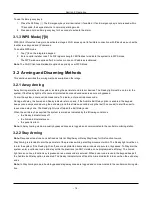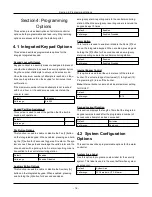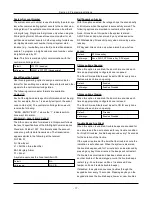
Section 4: Programming Options
DNS 2 IP Address
This is the resolved value based on the DHCP address
assignment.
Default:
000.000.000.000
Valid range:
Read-only
Access Code Required to View/Silence Troubles
This option is used to enable and disable the need to enter
an access code before viewing system troubles.
Default:
Disabled (Note: Access Code Required to View/Silence
Trouble shall be enabled for UL/ULC applications)
Valid
range:
Enabled, Disabled
Cellular Low Signal Trouble
This option is used to determine if the system will generate a
trouble event when a weak cellular signal is detected.
When enabled, a trouble event is generated if the radio sig-
nal level falls below threshold level (average CSQ level 4 or
less).
Default:
Enabled
Valid range:
Enabled, Disabled
Lockout Attempts
This option is used to program the number of invalid access
code entries allowed before the keypad is locked. When
keypad lockout occurs, the system is inaccessible by keypad
for the programmed duration. If the number of invalid
attempts is not reached within one hour, or if a valid access
code is entered, the counter is reset to 0 after 5 minutes.
Each keypad keeps track of it’s own lockout count and time.
Note:
The FAP keys are not locked.
Default:
0
Valid range:
0 to 255
Fire Supervision
This option is used to control system supervision of smoke,
CO and heat detectors. When this option is enabled, fire
detection devices are monitored over a four-hour period. If a
device fails to report within the four-hour window, a hard-
ware fault trouble is logged for the zone.
With this option disabled, fire detection devices follow the
programmed supervisory window up to a maximum time of
18 hours. After 18 hours, fire detection devices go into fault,
regardless of the programmed supervisory window.
Default:
Disabled
Valid range:
Enabled/Disabled
Wireless Supervisory Window
Use this option to program the time window for reception of
supervision (keep alive) signals from wireless devices
enrolled on the system. If a device does not report at least
once within the programmed time window, a hardware fault
trouble is generated.
Default:
24 Hours
Valid range: 1 Hour, 2 Hours, 4 Hours, 8 Hours, 12 Hours, 24 Hours
Wi-Fi Low Signal Trouble
This option is used to determine if the system will log and
report low Wi-Fi signals.
Default:
Enabled
Valid range:
Enabled, Disabled
Communication Cancel Window
This option is used to program the length of the Com-
munication Cancel window.
Entering an access code during the communicaiton cancel
window sends a code to the central monitoring station,
informing them that the previous event should be dis-
regarded.
The communications cancel window begins after the trans-
mission delay expires and a zone alarm is transmitted. If an
access code is entered during this window, a reporting code
is communicated and logged. If the window expires without
an access code entry or a code is entered after the window,
the communications canceled event is not logged or com-
municated.
Note:
The cancel window does not start after an Emergency
key alarm.
Default:
5 Minutes (UL/ULC)
0 Minutes (Standard)
Valid range:
5 to 255 Minutes (UL/ULC)
0 to 255 Minutes (Standard)
Swinger Shutdown
This value defines the number of communication attempts
made before the event goes into swinger shutdown. Once
the programmed number of alarm/restore events have been
communicated for an event, no further alarm/restore events
are sent until swinger shutdown is reset. The last restore
- 19 -


































